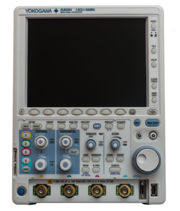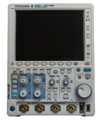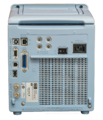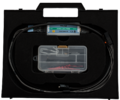Difference between revisions of "Yokogawa DLM2000 series"
Jump to navigation
Jump to search
Uwe Hermann (talk | contribs) m (Now supported.) |
Uwe Hermann (talk | contribs) m (→Devices) |
||
| Line 21: | Line 21: | ||
== Devices == | == Devices == | ||
{| border="0" style="font-size: smaller;" class="alternategrey sigroktable" | {| border="0" style="font-size: smaller;" class="alternategrey sigroktable sortable" | ||
!Model || Bandwidth || Channels | !Model || Bandwidth || Channels | ||
|- | |- | ||
Revision as of 19:06, 31 August 2014
 | |
| Status | supported |
|---|---|
| Source code | yokogawa-dlm |
| Channels | 2 or 4 |
| Samplerate | 2.5GSa/s (2chs interleaved), 1.25GSa/s |
| Analog bandwidth | 200-500MHz (depending on model) |
| Vertical resolution | 8bits |
| Input impedance | 1MΩ‖20pF 150V RMS CAT I or 50Ω 5V RMS |
| Memory | 6.25 to 250Mpts (model/mode-dependent) |
| Display | 8.4" 1024x768 |
| Connectivity | USB host/device, Ethernet (optional), Trigger in/out, GO/NOGO, VGA out |
| Website | yokogawa.com |
The Yokogawa DLM2000 series are 2- or 4-channel oscilloscopes with an analog bandwidth of 200-500MHz and 2.5GS/s sampling rate. See Yokogawa DLM2000 series/Info for more details (such as lsusb -v output) about the device.
Due to Yokogawa's focus on the controls industry, their oscilloscopes offer extensive analysis and reporting features.
Devices
| Model | Bandwidth | Channels |
|---|---|---|
| DLM2022 | 200MHz | 2 |
| DLM2032 | 350MHz | 2 |
| DLM2052 | 500MHz | 2 |
| DLM2024 | 200MHz | 4 analog / 3 analog+8 digital |
| DLM2034 | 350MHz | 4 analog / 3 analog+8 digital |
| DLM2054 | 500MHz | 4 analog / 3 analog+8 digital |
Photos
Protocol
The device uses USBTMC or LXI via its ethernet port for communication with a host PC. The protocol is based on SCPI commands.


